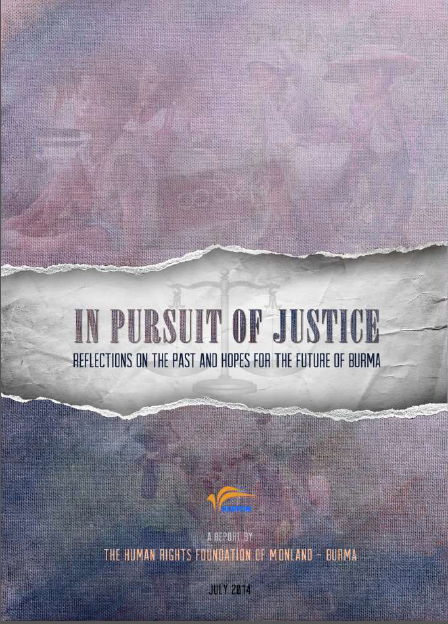In Pursuit of Justice: Reflections on the Past and Hopes for the Future of Burma
By Human Rights Foundation of Monland • July 8, 2014Since 2011, Burma has begun to emerge from 50 dark years of dictatorship. Now, under President Thein Sein’s nominally civilian government the possibility has arisen for Burma to begin rebuilding and reconciling divided segments of the nation, and to provide justice to victims for decades of human rights abuses.
Burma’s minority ethnic communities have experienced grave human rights abuse at the hands of the SPDC regime and its strong arm of the Burmese military, or Tatmadaw. In order to transition successfully towards true democracy and national reconciliation, the Burmese government must address, and act upon, the specific needs expressed by victims of past abuse, documented and expounded herein, in order to move away from the abusive culture of the past towards a united future.
Within this report you will find a detailed history of Burma’ ethnic conflict, how that conflict has been sewn into the very fabric of the SPDC regime’s ideology and governing strategy, and ways in which the Tatmadaw has implemented the regime’s strategy by crippling livelihoods, physically and mentally abusing, and destroying the security of Burma’s minority ethnic communities.
The purpose of this report is to guide the Burmese government in the implementation of mechanisms of transitional justice in Burma. To achieve this goal, this report looks at Burma’s history of human rights violations and analyzes how to repair the relationship between the government and the citizens.
The government has committed, and continues to commit, vast numbers of human rights abuses against its minority ethnic communities, violations including land confiscation; forced labor and forced portering; physical abuse, torture, and murder; and rape and sexual abuse. In order for the Burmese government to employ appropriate mechanisms of justice, this report identifies the effects such violations have had on the victims, and what the victims require from the government to provide adequate justice and reparations for such violations. Through this report, HURFOM hopes to hold a megaphone to the voices of Burma’s ethnic people regarding past human rights abuses.
This report addresses victims’ expectations of the government for a future democratic Burma. Of utmost importance to building peace in Burma are three key elements of trust-building, national reconciliation, and transitional justice. The government must implement appropriate mechanisms to fulfill these three objectives in order to create sustainable peace throughout the country.
Central to achieving these goals is the de-structuring of the SPDC’s pervasive culture of impunity surrounding human rights violations against its citizens. While impunity, unaccountability, extortion, and corruption continue to exist, there can be no repair of trust or unity within the society. Without eliminating all impunity, there will be no reconciliation in Burma.
Minority ethnic communities in Burma have been traumatized by decades of abuse and exploitation. It is HURFOM’s hope that this report will push the government to provide healing to the victims from such trauma with realistic solutions and reparations. HURFOM also hopes to attract the world’s attention and urge international agencies and Non-Government Organizations (NGOs) to support reparations in Burma.
Download the full report in English here
Tags: Burma Army, Government of Myanmar, Human Rights Foundation of Monland, Human Rights Violations, Justice, Mon, National Reconciliation, Sexual ViolenceThis post is in: Human Rights, Spotlight
Related Posts21st Century Panglong Conference Reaffirms Obstacles to Peace
Torture, extrajudicial killing, and use of civilians as human shields by Burma Army during new offensive against SSPP/SSA near Upper Yeywa dam site in Kyaukme
Time for a Fresh Start for Genuine Peace
An Open Letter to World Leaders on the Fourth Anniversary of The Resumption of War Calling Urgently for Humanitarian Aid for The Internally Displaced People of Northern Burma
The Burma Government Must Stop Condoning Sexual Violence in Conflict Areas










 All posts
All posts